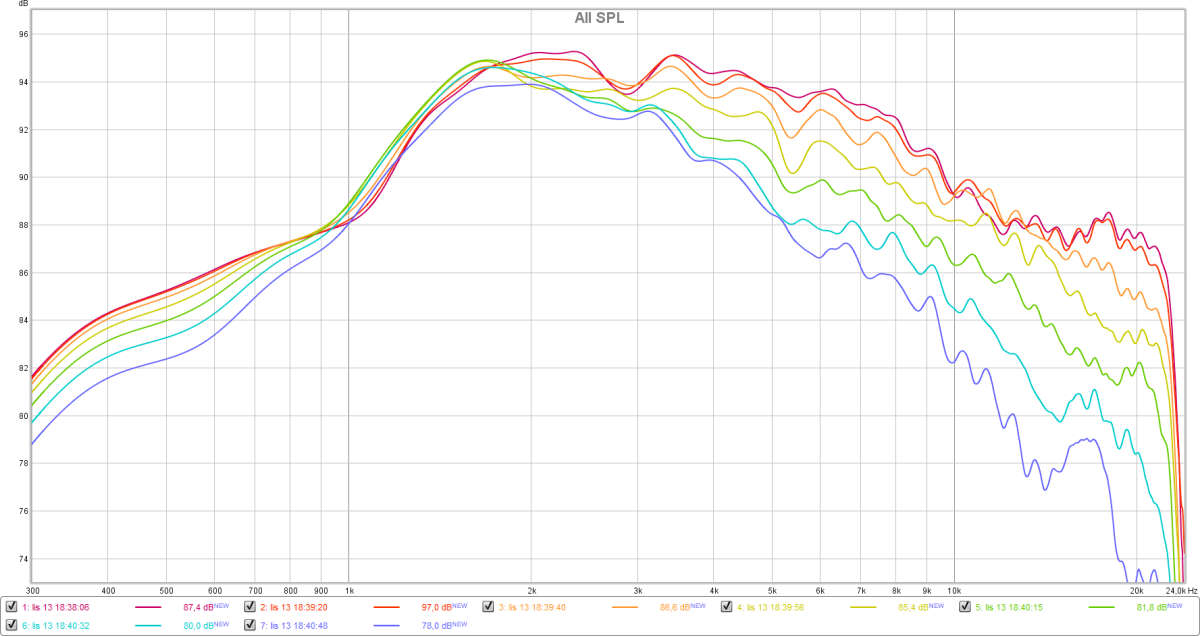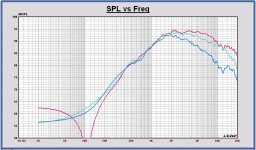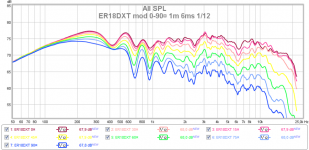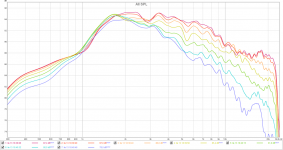The room was dead quiet🙂Not so clean as expected but fortunately consistent, not like those MWxxP with their edge problems... 🙂 Unfortunately CSD looks not that good. Are you sure the noise in environment was well controlled?
For drivers that have resonanse spike we decrease the low threshold at Y-axis on waterfall diagram to save useful range about 30dB total. Usually that threshold is -30dB, in the NE180W-04 case it is -40 dB. So, this can cause some misunderstanding.
Now I see... In fact it can be misleading, I was comparing to MW16P which also has no-shy peak at the response.
Perhaps we overlooked it when preparing files to publishing...Now I see... In fact it can be misleading, I was comparing to MW16P which also has no-shy peak at the response.
You can always publish both versions and let us to decide if we want to watch -30dB or -40dB, something like inside the tab with off-axis magnitude response.
Did you see new drivers from Tang-Band? I mean coaxials and that 40kHz 'High-Res' tweeter? Not saying about that DXT I could even send it to you but I accidentially burned its coil 3 months ago...
Did you see new drivers from Tang-Band? I mean coaxials and that 40kHz 'High-Res' tweeter? Not saying about that DXT I could even send it to you but I accidentially burned its coil 3 months ago...
You can always publish both versions and let us to decide if we want to watch -30dB or -40dB, something like inside the tab with off-axis magnitude response.
I'm not sure if it will happen to be. But we should be more careful in future certainly.
Didn't see them for a while.Did you see new drivers from Tang-Band? I mean coaxials and that 40kHz 'High-Res' tweeter? Not saying about that DXT I could even send it to you but I accidentially burned its coil 3 months ago...
I have found old measurements of SEAS DXT and will publish them next time🙂
Unfortunately they don't include offaxis measurements but it is better than nothing at all.
TB-speakers is more and more worth serious consideration.
Vance Dickason found extremely pleasing performance of this tweeter, despite its grille cavity resonance at 5 kHz which I believe is fixed in their 24-2234S with typical hexagonal grille...
Both W8-2314 and W6-2312 coaxials are already available in Europe, I'm curious if their bamboo cones deserve such a good tweeter inside.
Vance Dickason found extremely pleasing performance of this tweeter, despite its grille cavity resonance at 5 kHz which I believe is fixed in their 24-2234S with typical hexagonal grille...
Both W8-2314 and W6-2312 coaxials are already available in Europe, I'm curious if their bamboo cones deserve such a good tweeter inside.
Last edited:
TB-speakers is more and more worth serious consideration.
Both W8-2314 and W6-2312 coaxials are already available in Europe, I'm curious if their bamboo cones deserve such a good tweeter inside.
I think we should to write them a letter, maybe they will have wish to give some drivers for testing.
I always adjusted the level for CSD so that the bulk of the passband was at the same level for all drivers, so this exact issue is minimized. It's still a judgement call though, you're not matching flat lines.
HiFiCompass: I hope you won't mind if I add DXT off axis measurement. Measured in 200mm wide baffle with faceted edges.
Attachments
Last edited:
Thank you for an update, very nice curves really!HiFiCompass: I hope you won't mind if I add DXT off axis measurement. Measured in 200mm wide baffle with faceted edges.
The measurements of Beyma 5G40Nd have been added:
https://hificompass.com/en/speakers/measurements/beyma/beyma-5g40nd
https://hificompass.com/en/speakers/measurements/beyma/beyma-5g40nd
Slightly dissappointing performance especially in HD area. Slightly abnormal axial response in comparison to a bunch of other DXT tweeters I had an occassion to measure in the past. Weird behaviour at 20 kHz rather not typical to them. Probably they are running into consistency issues with latest drive units? Pida's DXT unit from earlier post is more typical.
Paul, it is good to see that my baffle did not make the performance much worse. The main difference I see is in directivity. My baffle keeps wider dispersion to higher frequencies.
Pida, on the contrary, w.r.t. directivity it is even better with the baffle, keeping the directivity more constant down to below 2kHz.
I just wanted to say that the directivity response can be improved choosing the right cabinet dimensions and shape.
I just wanted to say that the directivity response can be improved choosing the right cabinet dimensions and shape.
Here is my MarkK's ER18DXT speaker, both drivers with xo. My box is not exactly by his plans, it has offset tweeter and bevels on sides. My measurement doesn't show the cone breakup frequency at all. I should have changed the serial cap value for the tweeter.
DXT is a quite nice tweeter, but wg is actually very minimal so it works actually only from 3kHz up. Best match with 4-5" midranges!
DXT is a quite nice tweeter, but wg is actually very minimal so it works actually only from 3kHz up. Best match with 4-5" midranges!
Attachments
DXT tweeter on Grimm LS1 baffle in 10-degree increments.
2.83 Vrms @ 1 m distance, unsmoothed, 3.0 ms rectanguar gate, valid down to ca 1000 Hz.

There is diffranction on woofer suspension clearly visible at 2.8 kHz.

2.83 Vrms @ 1 m distance, unsmoothed, 3.0 ms rectanguar gate, valid down to ca 1000 Hz.
There is diffranction on woofer suspension clearly visible at 2.8 kHz.
Attachments
Last edited:
- Home
- Loudspeakers
- Multi-Way
- Some speaker driver measurements...



